| Reviews & Columns |
|
Reviews DVD TV on DVD Blu-ray 4K UHD International DVDs In Theaters Reviews by Studio Video Games Features Collector Series DVDs Easter Egg Database Interviews DVD Talk Radio Feature Articles Columns Anime Talk DVD Savant Horror DVDs The M.O.D. Squad Art House HD Talk Silent DVD
|
DVD Talk Forum |
|
|
| Resources |
|
DVD Price Search Customer Service #'s RCE Info Links |
|
Columns
|
|
|
Touch Of Evil - 50th Anniversary Edition
THE MOVIE:
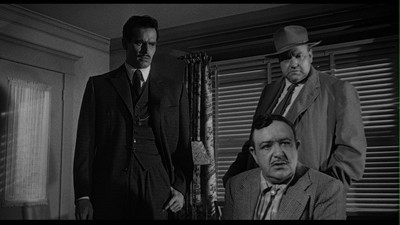
Some movies become just as legendary for the stories behind their making as they do for what's actually on the screen. Be they big-time flops like Heaven's Gate or the product of creative strife, like the director vs. studio monkeyshines of Blade Runner or Brazil, fans are as versed in the behind-the-scenes lore as they are in the films themselves. No one short of maybe Terry Gilliam is nearly as dogged by this kind of gossip as Orson Welles. Consistently fired off of projects and chronically losing his way in the middle of production, Welles' filmography is far too sparse to be so troubled. One of his most famous studio butcherings occurred on his second film, The Magnificent Ambersons, a movie that is still criminally absent from DVD shelves. He's already had a multi-disc compilation comparing various versions of another of his thrillers, Criterion's collection of Mr. Arkadin, and that has set the gold standard for what Welles' retrospectives should look like. Smartly, Universal has followed suit to give us the double-disc set of Touch of Evil: 50th Anniversary Edition.
Made in 1957 and released in '58, Touch of Evil is some kind of movie. Welles was brought on as the film's director at the suggestion of its star, Charlton Heston, after Chuck had heard the directorless picture had scored the former enfant terrible as its villain. Folks who have seen Tim Burton's Ed Wood, a biopic of another director who had trouble realizing his various visions, might remember the scene where Ed meets Orson, and Orson scoffs at Universal demanding he cast Heston as a Mexican. It's a good moment, though not entirely accurate. It's one of the many myths busted by the exhaustive extras on this new 50th Anniversary DVD: Welles rewrote the script to make Heston's crusading vice officer a Mexican and his wife into a white American woman, switching the nationalities from Whit Masterson's original novel, Badge of Evil. His epic bullfight between a corrupt cop and an idealistic attorney wouldn't have worked any other way, not with the thematic depth he envisioned.
Heston plays Mike Vargas, a powerful public servant who is in the middle of destroying the Grandi family narcotics ring in Mexico City. He is a newlywed, just married to Susie (Janet Leigh), a slightly naïve, uncultured American woman, and the pair have their honeymoon interrupted by a bomb planted in the back of an American construction magnate's car. It's dropped in his trunk on the Mexican side of the border, but it explodes just after her crosses into the States. This makes it a multijurisdictional crime, putting Vargas on tag-along with the bulldog Captain Quinlan (Welles, in padding and prosthetics), an aging detective with a reputation for an uncanny intuition. Quinlan doesn't like having a Mexican do-gooder sniffing his tracks, but he'll make the peace even while he gets his man.
Except Vargas realizes there is something fishy when Quinlan so quickly zeroes in on the nervous shoe clerk Sanchez (Victor Millan), who has been shacking up with the dead man's daughter (Joanna Moore). He suspects Quinlan of planting evidence, and he makes it his mission to prove that the gumshoe's record is less about getting lucky and more about making the luck himself. This in turn pushes Quinlan to team with Joe Grandi (Welles regular Akim Tamiroff), the Stateside brother of the man Vargas is working to put in jail back in Mexico City. Grandi would rather see Vargas' reputation ruined than Quinlan's, because it would change the jury's mind against the big-shot cop back home. The chubby gangster has already started working on that, setting up Susie Vargas for a sex and drugs scandal that her hubbie will have a hard time explaining away.
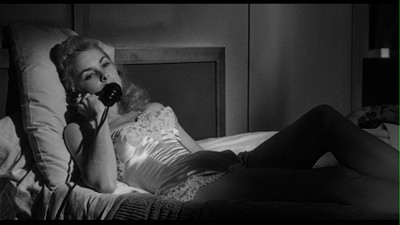
Touch of Evil is a grand, spiraling puzzle. Taking place over 48 hours, it moves at a rapid-fire pace, with story lines and motivations criss crossing over one another with just about every scene change. Welles envisioned the border town as a metaphor for a moral line in the sand. For his matador and his bull to cross back and forth over that line, they also end up crossing over lines of what is acceptable and even legal. Each side of the town is neither solely Mexico nor solely the U.S., but a gray area that makes how a man operates appear murky. Quinlan may be rotten, but he also believes in the guilt of every crook he frames; Vargas may claim to an ethical superiority, but he is not above bending his moral compass to get what he wants. As he tells the thug "Pancho" (Valentin de Vargas) when he's been pushed too far, "Listen, I'm no cop now. I'm a husband!"
Welles' plot is one of multiple layers, each one contingent on the one beneath it. Thus, when the studio released a cut of the movie to test audiences that had not been approved by the director, he had cause to react. Now dubbed the "Preview Version," it was actually believed to be the director's cut of Touch of Evil when it was discovered in the 1970s. The truth is, there is no approved director's cut, Welles never got to edit the picture to his satisfaction. This 1-hour-and-49-minute version, released here as part of DVD 2, was actually so hated by Welles, he fired off a 58-page memo to Universal asking for specific changes to be made before Touch of Evil was commercially released. The studio chose to largely ignore Welles' demands, and they also chose not to let the director back into the editing room. They did, however, cut the movie down to 1-hour-and-36-minutes for the "Theatrical Version," which is also on DVD 2.
The major difference between the first edit and the released version involve shuffling some material around and dropping some major scenes that add a lot to character and plot elements within the story--most notably, a lot of the material with Quinlan's sidekick, Pete (Joseph Calleia), particularly his explanations about Quinlan's bum leg and his picking up Grandi when the crime boss is spotted trailing him when he's taking Susie to a new hotel. Both cuts feature the Henry Mancini score that Welles would have preferred be traded for source audio, and they also dismantle the director's complicated montage jumping between the first crime scene and Grandi and Pancho targeting Susie early in the picture.
I actually like the theatrical version, though a lot of that is nostalgia. It's how I best remember the picture, having seen this cut of Touch of Evil multiple times before there was ever a second option. The Mancini music over the top of the legendary 3-and-half-minute tracking shot that opens the movie adds a jazzy zip to the scene that is not without its virtues. That said, when producer Rick Schmidlin, editor and audio whiz Walter Murch, and critic Jonathan Rosenbaum sat down and reconstructed the movie using Welles' memo as a guide and released it as the "Restored Version" in 1998, its superiority was immediately apparent.
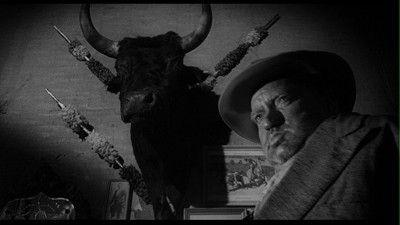
Orson Welles was a virtuoso storyteller. His instinct for what made a tale tick was on par with Quinlan's bum leg for ferreting out bad guys. The way he saw Touch of Evil, and the way it appears in the restoration, is as a labyrinthine tower of secrets and lies that draws the audience into its maze through a confusing series of switch-ups that ultimately accumulate to reveal a large, intricate picture of corruption, racism, sexual politics, and personal morality. In its refurbished state, Touch of Evil is a breathless viewing experience. Welles' magical camerawork, shot by Russell Metty, is as meticulously designed as his plotting, the construction of each scene and how it flows being inextricable from the information it is meant to impart. Thus, it must have been heartbreaking for the great genius to watch the studio strip the film down and treat it as a standard crime picture where the only thing that mattered was that the right guy died in the end. The movie failed on its initial release, though it gained a solid reputation over time, one that only increased when the restoration showed how much more Touch of Evil could have been. Vindication came far too late for Welles to appreciate it, but it came all the same.
Which, again, puts the story of the movie out in front of the movie itself, a situation that is quickly remedied once you view Touch of Evil for yourself. It's a marvelous motion picture, full of fantastic performances. Welles, Tamiroff, and Heston make for amazing sparring partners, and Janet Leigh and Marlene Dietrich, in a cameo as a gypsy fortune teller who may have been Quinlan's former lover, serve as parallel but opposing female forces, one not having seen enough of life and thus under threat, the other having seen too much and thus untouchable. I must also mention Dennis Weaver's off-kilter performance in the role of the mentally askew hotel manager. He doesn't get a lot of screen time, but with his stuttering speech and manic body language, he's hard to forget.
Just as all of Touch of Evil is hard to forget. It's a movie you'll want to start over again the moment it finishes, even as its famous last lines, as delivered by Dietrich, still ring in your ears. It was actually a pleasure to watch all three versions of the movie over the course of the last three days, each one revealing something different, and each time the quality of the filmmaking shining through no matter how hard the powers that be tried to blot it out. I always lamented not having the theatrical cut when the initial DVD was released, even going so far as to hang on to an old VHS copy. Thank goodness Universal decided to finally do right by this film and give it the birthday celebration the occasion calls for. The Touch of Evil: 50th Anniversary Edition isn't just a present to the production to honor its half-century of entertaining, but it's a fantastic gift to film fans who have been patiently waiting to get the entire story.
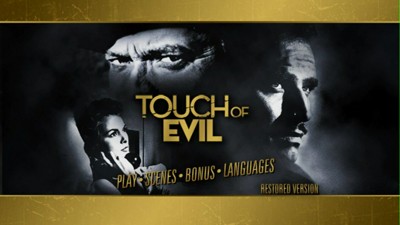
THE DVD
Video:
All three versions of the film on the Touch of Evil: 50th Anniversary Edition receive anamorphic transfers maintaining their 1.85:1 aspect ratio. The two earlier versions on DVD 2 don't get the super restoration treatment the main version does, and they have considerably more surface noise such as scratches and dirt than the 1998 version on DVD 1. Overall, they look about average for an old movie and don't have any egregious digital problems such as edge enhancement or artifacting.
The transfer for the 1998 Restored Version looks remarkable. It's the only cut of the film that has been released on DVD before, having had an edition in 2000. I expected the two discs to be virtually the same, but was surprised to notice that they were not when I did a random comparison. Here are three screengrabs I pulled from both editions:
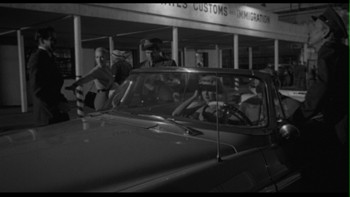
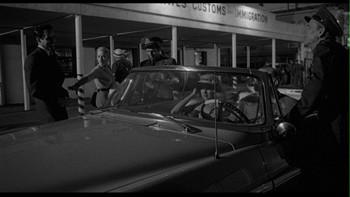
2000 vs. 2008
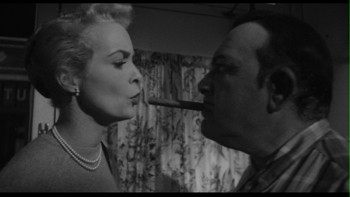
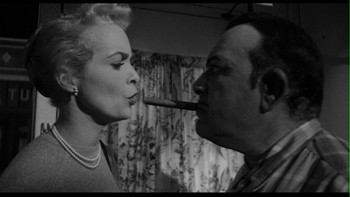
2000 vs. 2008
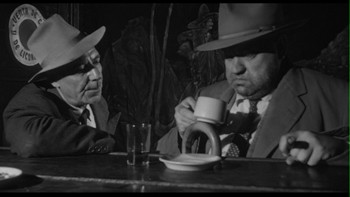
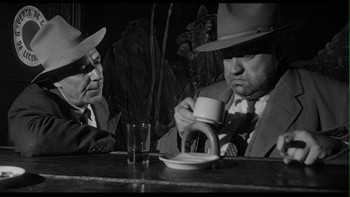
2000 vs. 2008
I think the new disc shows a subtle but marked improvement over the original 2000 DVD. The image is sharper overall, and there is a stronger quality to the blacks on screen. I was surprised to see how faded and light the old disc looked by comparison, as I had always remembered it being pretty good. Well, as good as it was, this new transfer is better. Almost completely free of dirt or grit, it looks crisp, with excellent contrast in its black-and-white photography and plenty of clarity on the detail-packed images Orson Welles put so much effort into bringing to life. You can even see slightly more information on the sides. Check the second and third examples, the left of the frame, there is more of the decoration in each shot in the 2008 version.
Sound:
Every version of the movie gets a Dolby 2.0 mix that preserves the original nature of the soundtrack. It would have been easy to go overboard with a 5.1 mix, given the depth of field and even the original desires of Orson Welles, but I think this was the smart way to go. The sound quality is very good, with the audio cleaned up nicely and maintaining a good level of volume throughout.
The subtitle options are French, Spanish, and English for the Deaf and Hearing Impaired, and they are there for all three cuts of the film. The commentary on disc 1 with Heston and Leigh has a Closed Captioning option, also.
Extras:
The double-disc Touch of Evil: 50th Anniversary Edition is packaged in a regular-sized DVD case with a hinged interior tray to give two separate spots for the discs. There is a paper insert advertisement for Turner Classic Movies and other classic films on DVD.
An oversized slipcase fits both the DVD case and a paper reproduction of Welles' infamous memo detailing the changes he wanted in the Universal preview cut, the memo that the restoration team used to piece the film back together. The reproduction comes in a paper envelope made it look like interoffice correspondence, and the facsimile memo is held together with a single corner staple.
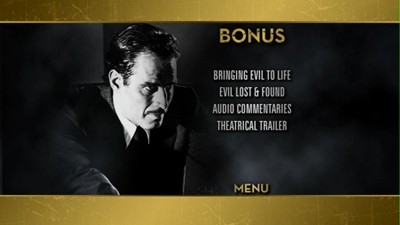
There are four audio commentaries spread across the two discs:
* Restoration Producer Rick Schmidlin (Restored Version, Disc 1)
* Charlton Heston, Janet Leigh, and restoration Producer Rick Schmidlin (Restored Version, Disc 1; erroneously listed on the DVD packaging as corresponding with the Preview Version)
* Author and filmmaker F.X. Feeney (Theatrical Version, Disc 2)
* Welles experts Jonathan Rosenbaum and James Naremore (Preview Version, Disc 2)
Schmidlin spends much of his time explaining the edits he, Murch, and Rosenbaum made and how they interpreted Welles' memo, while his track with the actors is more production oriented (all three people are in the same room, with Schmidlin moderating). The two commentaries on the earlier cuts give the lowdown on what is different, alongside the opinions of the speakers on the movie overall. F.X. Feeney's is my favorite track, with Feeney making some good arguments for why some things in the Universal cut worked, why some didn't, and even noting where the studio actually appears to either have paid attention to Welles' memo or at least somehow ended up on the same page.
There are two new documentaries on DVD 1. "Bringing Evil to Life" (21 minutes) deals specifically with the production of the movie, while "Evil Lost and Found" (17 minutes) picks up when shooting wrapped, detailing the problems the production faced in editing and then the restoration effort undertaken in the late '90s. Both cull from the same interviews, which include actors Charlton Heston, Janet Leigh, Dennis Weaver, and Valentin de Vargas ("Pancho" in the movie), Welles confidante Peter Bogdanovich, the restoration team, and admirers like directors Robert Wise (The Set-Up) and Curtis Hanson (L.A. Confidential). Most of the information shows up in the commentaries, as well, but these featurettes are much more succinct and include every anecdote fans of the film could want. The "Evil Lost and Found" program ends with Hanson taking us on a quick tour of the Venice Beach locations Welles used to see how they look today.
DVD 1 is rounded out with the original theatrical trailer.
For those wondering how this edition stacks up against the 2000 DVD as far as extras are concerned, the original release had hardly any supplements at all. The theatrical trailer and the Welles memo were included then, but the latter was as a text version on the disc itself, which is rather lengthy to read on screen. The old disc also had some text production notes and info about cast and crew; these have not been carried over and are no great loss.
FINAL THOUGHTS:
The Touch of Evil: 50th Anniversary Edition is the kind of scholarly, celebratory treatment of a fantastic film that has only become possible in the last decade thanks to the advent of DVD technology. Providing three versions of Orson Welles' influential crime picture, it allows fans to compare and contrast the alternate cuts that have marked the production's troubled history. Considered by many (including me) to be the cherry on top of the film noir genre, it is an intricate tale of how good men can become corrupt and how bad men will always take advantage. Loaded with commentaries and a couple of bonus documentary features, this new edition has everything you could want in order to better understand where Touch of Evil came from and how it finally became the revered film that it is. A must-have, and thus now part of the DVD Talk Collector Series.
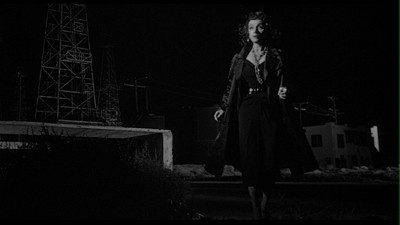
Jamie S. Rich is a novelist and comic book writer. He is best known for his collaborations with Joelle Jones, including the hardboiled crime comic book You Have Killed Me, the challenging romance 12 Reasons Why I Love Her, and the 2007 prose novel Have You Seen the Horizon Lately?, for which Jones did the cover. All three were published by Oni Press. His most recent projects include the futuristic romance A Boy and a Girl with Natalie Nourigat; Archer Coe and the Thousand Natural Shocks, a loopy crime tale drawn by Dan Christensen; and the horror miniseries Madame Frankenstein, a collaboration with Megan Levens. Follow Rich's blog at Confessions123.com.
|
| Popular Reviews |
| Sponsored Links |
|
|
| Sponsored Links |
|
|
| Release List | Reviews | Shop | Newsletter | Forum | DVD Giveaways | Blu-Ray | Advertise |
|
Copyright 2024 DVDTalk.com All Rights Reserved. Legal Info, Privacy Policy, Terms of Use,
Manage Preferences,
Your Privacy Choices | |||||||













